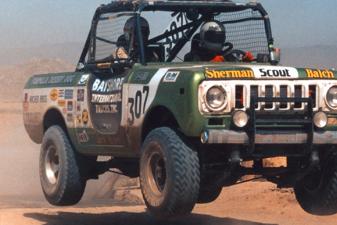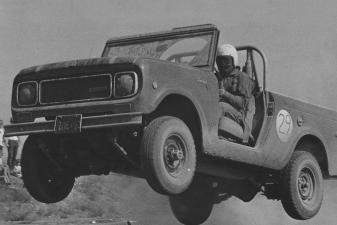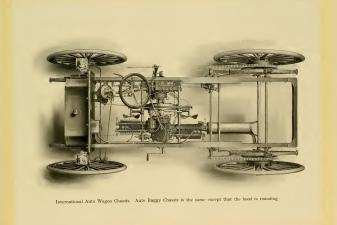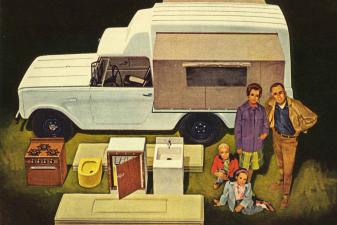Scout Specials: U.S. Ski Team, Spirit of '76, Patriot, and Sno-Star

The following is an excerpt from the book, International Scout Encyclopedia, by Jim Allen and John Glancy.
Veteran journalist and four-wheel drive historian Jim Allen and recognized collector and Scout expert John Glancy built the most in-depth book about Scout trucks on the market. This excerpt discusses the special edition, 1976 Patriot, and Sno-Star Scouts inspired by the U.S. Olympic Ski Team's Spirit of '76.
The Spirit of ’76, Patriot, and Sno-Star Scout specials began with the decision to supply Scouts for the U.S. Ski Team. The Olympics were taking place on the nation’s Bicentennial and it isn’t difficult to grasp the potential advertising benefits of a special for a U.S. team. The idea easily translated to Bicentennial-themed specials eventually known as the Spirit of ’76, Patriot, and Sno-Star and all used the same appliqué option, listed most commonly as “Spirit Appliqué,” on a Winter White body (10876). The packages differed slightly, but they could be ordered with any available powertrain and many other à la carte options. A thorough search for all 1976 Scouts with this option code turned up a total of 451. The vast majority were Spirit of ’76 Scouts, but a further breakdown of each is below.
Today there are Scouts with what appear to be period-original Spirit or Patriot appliqués whose LSTs do not have the appliqué option code. Most likely, these appliqués were applied at the dealer, since they were available from the parts department. So are these “real” Patriots or fakes? Best to let the Scout collecting community make that call and buyers and sellers to negotiate market prices. With the availability of reproduction Spirit and Patriot appliqués, it is possible to create a “fake” Patriot or today to generate a higher price. In the case of negotiating a high-dollar for a Spirit or Patriot, LST documentation or a dealer invoice should be the arbiter of price.
The first appearance of the red, white and blue appliqué came with the 17 Olympic Scouts built late in 1975 for use by the U.S. Ski Team before and during the 1976 Winter Olympics. One of the seven 100-inchers is shown above, one of ten in the entire group that mounted 8,000 lbs. Warn 8274 electric winches on a Warn bumper mount. This is essentially the same package as the Sno Star version of the 100-inch Traveltop, which would be virtually identical except for the Ski Team decal. Note the XLC decal on the rear fender. This is an indicator of very late ’75 production or very early ’76. WHS110958
U.S. SKI TEAM SCOUTS
International created a press goldmine by supporting the U.S. Ski team in 1975–1976 with a fleet of 17 Scouts just in time for the 1976 Winter Olympics at Innsbruck, Austria, held February 4–15. These included 10 of the new long-wheelbase Travelers and seven Scout II Traveltops. All had what amounted to the Patriot or Sno-Star package. Ten of the 17 had Warn electric winches mounted on Warn bumpers. A large “U.S. Ski Team” decal was added to front fenders just above the IH emblem, and some units are seen with driving lights. It was a striking package and probably the envy of other participants in the Winter Olympics.
A December 29, 1975, International press release stated that all U.S. Ski Team Scouts were 4x4s featuring V-8 engines, automatic transmissions, two-speed transfer cases, bucket front seats, ski racks, and AM-FM radios. The press release reported six of the Travelers were shipped to Europe to be used in Innsbruck and in World Cup events. The others were stationed at, or shuttled between, training camps in Cooke City, Montana, Thunder Bay, Ontario, Mission Ridge, Washington, and several places in Colorado.
Some digging uncovered the ten Travelers in the LST files. All were built on September 11, 1975. The Spirit/Patriot appliqué option code was not found on the LSTs, likely because it had not yet been assigned a code number. They are, however, marked in the ship-to box with a team shipping address in Chicago. The LSTs indicate an order of ten, which does fit the release information, and all the options match; Winter White (9219), Wedgewood Blue Deluxe interior with buckets (16872, 16928, 16709), and Deluxe exterior (16835) and luggage rack (16903). In addition, the LSTs indicate the V-345, automatic transmission, two-speed transfer case, limited-slip rear, and 3.54:1 ratios.
The fate of most of these U.S. Ski Team specials was unknown until 2012 when one of the Travelers sent to Europe was found in Belgium in tough shape and acquired by a collector. The others may be hiding in plain sight. Their VINs, in order of their line sequence numbers, are: FGD14119, FGD14125, FGD14135, FGD14142, FGD14148, FGD14154, FGD14160 (the Scout found in Belgium), FGD14172, and FGD14178. LSTs were not located for any of the seven 100-inch U.S. Ski Team Scouts.
Ten of the 17 Ski Team Specials built were Travelers. The appliqués were just the same as the Traveltops, just a bit longer. Again, the Sno Star or Patriot Traveler would be virtually identical in appearance except for the Ski Team decal. The Ski Team rigs were all V8 automatics. Some, including this one, had the Warn 8274 winch package, which was also available to customers. Note the absence of the XLC sticker on the rear fender. This image was released December 3, 1975. We know all ten of the Ski Team Travelers were built September 11, 1976 and came off the line equipped identically. WHS113472
SPIRIT OF ’76
The 1976 Bicentennial inspired almost every American auto and truck manufacturer to build commemorative vehicles. An artist’s conception of International’s Spirit of ’76 was done by the Styling team at Fort Wayne in the fall of 1975, about the same time that the U.S. Ski Team specials appeared. The pilot production model was built March 5, 1976, (VIN FGD33458) and was one of the minority powered by a 4-196.
The Spirit option came only on a 100-inch Scout II in Winter White (9219) with a Traveltop delete code. The package consisted of the Spirit appliqué, Wedgewood Blue Deluxe interior, color-keyed roll bar (painted blue to match the interior), Sport steering wheel, blue denim Safari soft-top, and 10-15 Goodyear Tracker AT tires on seven-inch chrome Rallye wheels. Any drivetrain combination was possible.
The bulk of the Spirits were built April 12–June 1, 1976, the last being VIN FGD43099 with a V-345, T-407 automatic, rear limited slip, and 3.54:1 axle ratios. LST records indicate a total of 369 Spirit of ’76 Scouts, 18 of which had the single-speed TC-143 transfer case. Only one was a diesel. There was also one 4x2 Spirit and one Spirit with a 4-196 mated to a T-407 automatic. Very few were ordered with air conditioning. Both bench and bucket seats were available but most came with buckets, many with the center console.
In May 1976, a group of southern Illinois dealers held a “Spirit Driveaway” in which 33 Spirits (as determined by the resulting marketing photos) were driven to their respective dealers from Fort Wayne, forming a mile-long convoy. The LSTs for 16 units produced April 12–13 are marked “Spirit Driveaway.” A May 19 press release heralded the event, citing 40 dealers that participated.
The LST is needed to verify a Spirit. It will have a Scout 100-inch wheelbase with a 9219 paint code (Winter White). Also present will be the Spirit appliqué (10876), Omit Travel Top (18696), Deluxe Interior (16928), Wedgewood Blue interior (16872), Sport steering wheel (057090), seven-inch chrome wheels (29091), and 9-10-15 front and rear tires plus spare (925102, 925202, and 885102). Some, but not all, have “install roll bar,” and “install convertible canvas top” written on the LST. Often, near the bottom, there’s a typed “Spirit PKG” note. Most often, there is a hand-written “Spirit” in the ship-to box on top, and the option codes are typed with “TSPC, Fort Wayne, IND” also in the ship-to box.
On occasion some or all of the Spirit options are hand-written on the LST. In some cases, it appears a Scout in the right color and options was purloined on the line to become a Spirit, even if it wasn’t originally planned as one. In this case, a shipping address on top might be changed or added, and the side appliqué and special wheel and tires may be hand-marked to be installed at TSPC (Truck Sales Processing Center). It’s still a “real” Spirit, as long as those notations happened at the factory.
Dave Higley created the first rendering of the Spirit of ’76, probably about the same time as the Ski Team specials were being built. We know this rendering was created in the fall, but not released until December 3, 1975. WHS111085

This image was in the first press packet announcing the Spirit, dated January 22, 1976. Knowing the very first LST with the Spirit appliqué shows up on March 5, we can safely conclude this is a Styling Department Scout and very likely the Spirit prototype. Note the XLC emblem on the rear quarter panel. 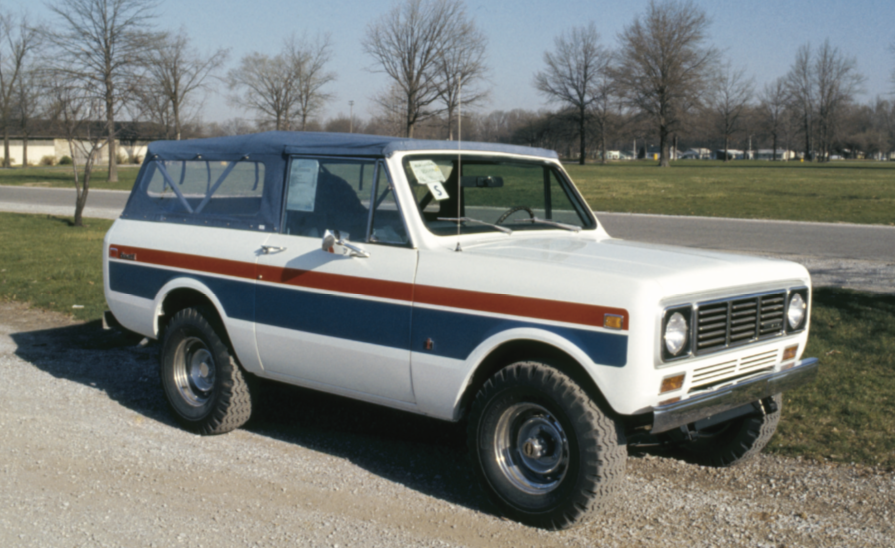
A production Spirit of ’76 was photographed at the Styling Department in April of ’76. In LST research, we found a large batch of Spirits built in that month. Note no XLC emblem is present, unlike the Ski Team unit. 
The rear ¾ view of the Spirit gives us a better look at the blue denim top made for International by Kayline. The material in this top was virtually the same as used in Jeep’s “Levis” option.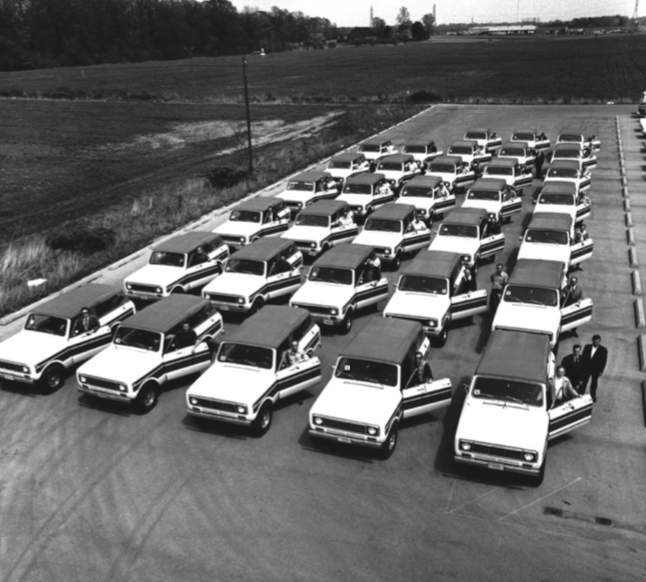
The Spirit Driveaway! Around May 19, 1976, 33 Spirits were assembled so a group of Illinois dealers could drive the new Scouts back to their respective dealers around the state as a publicity event. We found 16 LST from mid-April that were marked “Spirit Driveaway” and presumably those Scouts are in this image. WHS
PATRIOT
The Patriot was a hardtop variation on the Spirit of ’76. Unlike the Spirit, it was available on both the 100- and 118-inch Scouts. The Patriot package came on a Winter White body with a Wedgewood Blue Deluxe interior, but it didn’t include the roll bar, Sport steering wheel, or the wheel and tire package (though all could be added, except the roll bar on a Traveler). Any other option could be added, as well, even the Deluxe Exterior, which included extra body trim and side molding. Two LSTs marked “Patriot” (no Traveltop omit code) included the 10-15 Goodyear tire and chrome wheel option, something that could be added to any Scout that year. This could lead to confusion or a claim of a “rare and coveted Spirit Hardtop,” but the LST tells the true tale.
In theory, a “true” Patriot has an LST showing the Winter White paint code, the Spirit appliqué (sometimes written “patriot appliqué” on the LST, though with the same option number), and the Wedgewood Blue interior. Most LST’s found in the archive are also hand-marked “Patriot” at the top, though some aren’t, having only the 10876 Spirit appliqué code. Some, mostly those built late in the run, also list “Patriot package.” All that were found had the sliding rear quarter windows, and there was a mix of engine and transmission combinations.
In all, 42 Patriot LSTs were found. The first of these had a March 19, 1976, build date (FGD33989) and the last came on June 2 (FGD43271). Sixteen were 118-inch Patriot Travelers, the first of these coming March 28, 1976 (FGD35692). One was a 4x2, and there was one diesel Traveler marked as a Patriot but which appears to be a special thrown into a fleet order, probably as a favor, with the appliqué code handwritten. Howard Pletcher reports finding a record of one among the records at Navistar, but it could not be located decades later.
SNO-STAR
International announced a Sno-Star at the same time as the Spirit and Patriot. It’s rare (but not so special) and difficult to tell from a Patriot. Basically, it was a Patriot package with the standard luggage rack and a ski attachment. The only other indication was “Sno-Star” written on the LST. There is no mention of the ski attachment on the LST and it’s unclear whether that was installed at TSPC or at the dealer. Only six LSTs marked “Sno-Star” were found: five 100-inch Traveltops and one Traveler.
But is a Patriot with a luggage rack and a ski rack a Sno-Star? The luggage rack (16903) was present on many Patriots, so the dealer could attach the ski rack which was available as an accessory. It’s difficult to attach too much special status to the Sno-Star option but it is interesting if an LST is so marked. Technically, it seems the LST has to say “Sno-Star” for it really to be one.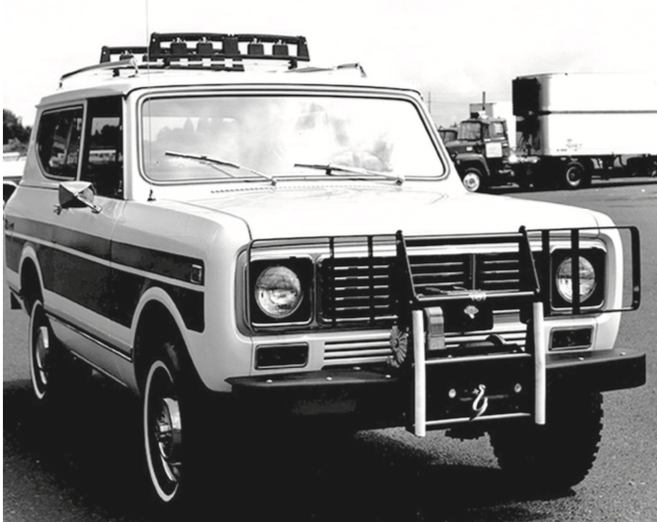
This appears to be a Sno Star (note ski rack) with a winch, a Patriot with a ski rack and a winch, or possibly one of the Ski Team Scouts at some early stage. What sets this apart is the Warn brush bar, which is not seen on any of the Ski Team Scouts but was available in the Scout accessories catalog of 1976. WHS
Author's Note (January 15, 2020): It's a well-known phenomenon that when you produce an historical account of an automobile not well represented in other books, it will unlock floodgates to new information. That certainly proved true when International Scout Encyclopedia was published in 2016. The authors were positively drenched with new information on every level of the International Scout continuum. Among the many tidbits was new information on the 1976 Patriot special editions. Stay tuned for additional information on the 1976 Patriot special editions!


